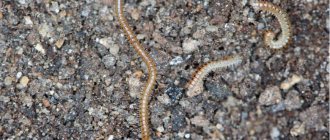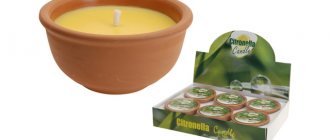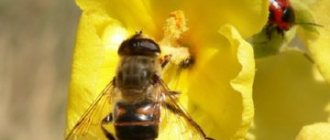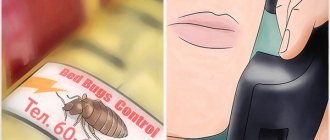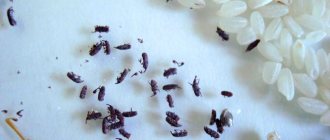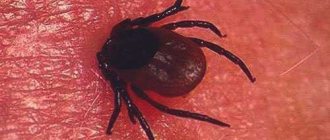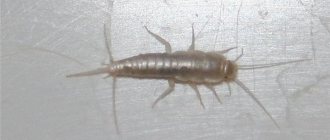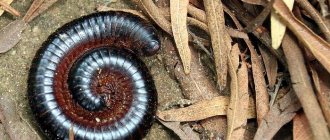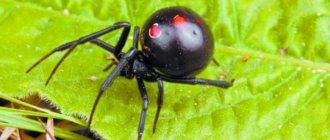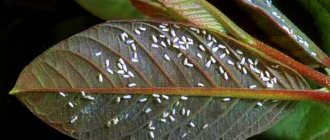These multi-legged invertebrates do not make noise, do not bite, are not aggressive, and some especially large and colorful representatives of the order are even bred by amateur enthusiasts in home terrariums. But summer residents usually look towards strange arthropods with caution - will they cause harm to the plants?
Who are these “worms”, what do they look like, where do they live, what do they eat, are they dangerous for humans or garden crops, and do we need to get rid of them? Let's sort it out in order.
Description, development, reproduction
The body color of the nodule can range from light brown to black. Their body is cylindrical or very close to this shape, like a worm, and can consist of 30 or more segments. The organs of vision are represented by two separate eyes, sometimes absent. Each segment contains two pairs of legs, with the exception of the three front ones.
Females and males have some differences in appearance. Males have homopods - modified legs that serve for external-internal fertilization. They are located in the inner part of the head segment.
When moths sense danger, they secrete a substance with a strong, unpleasant iodine odor. Many animals use this. For example, lemurs scare centipedes and then rub themselves on them to ward off predators. It has been noticed that the brighter the pest, the stronger its smell. Kivsyak can leave dark spots on the body that do not wash off for several days.
Habitats
Animals living in temperate latitudes usually live in litter - wood, grass, leaves, which also becomes their food.
Most of them are in deciduous, mixed forests, and forest-steppe zones. They rarely go to a depth of more than 30 cm. The arthropod does not tolerate direct sunlight. When cold weather sets in, the pest burrows deeper into the soil, where it remains until spring.
Stages of development
Kivsyak lays eggs in the soil. The larvae that hatch are no different from adults, only they have fewer body segments. It increases in length with each subsequent molt.
The female's fertility decreases under unsuitable conditions - low air humidity, lack of nutrition. If the conditions are favorable, then the nodule can live ten years or more.
Kivsyaki have 5 superfamilies and several families. Some species are poisonous.
Habitat
The common flycatcher can be found in many temperate regions. In Russia, this is the Volga region, the southern regions, the insect lives in the northern part of Africa, Europe, the Middle East, and Mediterranean countries. Under natural conditions, centipedes hide under stones, fallen leaves, and plant remains. The domestic centipede hunts at any time of the day.
They move to human housing with the onset of autumn cold weather. Prefer dark and damp places:
- basement;
- bathroom;
- toilet.
During the winter, the insect hibernates and becomes active only when the weather warms up. In southern countries, centipedes are treated kindly, because they help exterminate pests.
Harm and benefit
Arthropods should not be considered solely as pests. After all, in one season, grasshoppers can process up to 50% of plant waste, providing the soil with minerals and promoting the formation of soft humus. This soil is useful, for example, for rose bushes. But as soon as the moisture balance is disturbed, the arthropod turns into a malicious pest.
Kivsyak is an extremely voracious pest. During the day he eats a portion of food that is one and a half times his weight.
An animal living in the soil damages the root system of seedlings - tomatoes, cucumbers, strawberries, wild strawberries. Therefore, terrestrial organs do not receive enough nutrients. As a result, the development of plants stops, they gradually wither and die. Moreover, he will covet
In addition to roots, it feeds on strawberries and cucumbers lying on the ground or near its surface. When there is a shortage of food, centipedes can feed on green shoots and seeds. They even harm young trees - apple trees, pears, melons, tomatoes, raspberries.
Expert opinion
Mityuk Stefania Bogdanovna
Not everyone is trying to get rid of their kinks. There are people who breed them at home. Exotic lovers are attracted to invertebrates by their unusual appearance. The African species of these arthropods are especially beautiful.
Centipedes in the house, why are such neighbors dangerous?
The appearance of a flycatcher in a house does not threaten its residents. The insect is more active in the dark, so the risk of encountering it will increase at night. When the light is turned on, the centipede rushes to a secluded crevice. If a centipede is spotted in a house in the summer, it is better to catch it and take it outside. You need to catch it not with your hands, but with a can or box. In tropical countries where there are no harsh winters, flycatchers do not migrate into houses.
Having settled next to a person, the insect does not encroach on his food, plants and pets. Centipedes do not chew furniture or wallpaper and are not carriers of dangerous diseases. There will also not be an invasion of large numbers of flycatchers; they do not live in families. You can get along peacefully with them, even benefiting from such a neighborhood. The little predator copes well with annoying flies, and if cockroaches are hiding in the apartment, the centipede will get to them.
Is the centipede dangerous for humans? If there is a clear threat to life, such as a pet or human attack, it may bite and inject venom under the skin. A small dose of a paralyzing toxin is not lethal to pets, much less to people. It causes an unpleasant sensation, but no more than a bee sting. A tendency to be allergic to insect venom can aggravate the situation, causing swelling and general malaise.
Do centipedes bite?
Even the most non-aggressive creature can bite out of fear. A flycatcher, even if it attacks an adult, in most cases will not be able to bite through the skin. Children's skin is more delicate and thin, so getting wounds is real. Symptoms of toxin entering the body include redness, itching and burning. What to do if bitten by a centipede? The first piece of advice is don't panic. The poison is very weak and will not cause any harm to health. It is worth acting according to the circumstances:
- disinfect the wound with alcohol or hydrogen peroxide;
- if there is a strong burning sensation and swelling, you should apply a cold compress and hold it until the discomfort disappears;
- if the bite site hurts, take an antihistamine and pain reliever.
Attention. Individual intolerance to flytrap venom can lead to complications. If symptoms of an allergic reaction appear - weakness, dizziness, breathing problems and others, you should go to the hospital.
How to get rid of a flytrap
Not everyone likes the presence of an unpleasant insect in the house, which can fall from the wall directly onto anyone’s head. Many people are afraid of a centipede bite and its consequences. A change in the conditions that are comfortable for it can force the common flycatcher to leave its favorite place. Simple and affordable actions against centipedes:
- The flycatcher loves dampness - it is necessary to ensure a normal level of humidity. Wipe up puddles on the floor in a timely manner, fix leaking taps, and do not leave wet wipes or rags on.
- Airing and good ventilation also reduce humidity in the room.
- Check the basement; there is often an accumulation of rotten boards, old paper, mold and dampness.
- Try to deprive the flytrap of food, destroy flies, cockroaches and other prey yourself.
- Block possible routes of entry into the house - fill cracks with mortar, put screens on windows, repair cracks in the wooden floor.
Attention. Sticky insect traps placed on the floor will not help get rid of the common flycatcher. She runs away from the tape, leaving several detached legs on the surface. This is a small loss for the centipede, because the legs grow back over time.
The centipede or flytrap is not the most pleasant neighbor, but it is useful. Various insect parasites exist hidden in every home. The predatory centipede effectively destroys pests. If you ignore her repulsive appearance, it will be a mutually beneficial partnership.
Pest control methods
Because of the chitinous “body armor”, it is quite difficult to fight the pest that has chosen the site.
Chemicals
In this case, they do not always bring the same effectiveness as in the fight against other pests. The reason for this is the same chitinous shell that covers the body of the invertebrate. However, chemicals can be effective against larvae that do not have a chitinous coating.
Spraying the stems and treating the seed rarely produces results. The fact is that the animal only gnaws the roots of plants.
Aktofit
The active ingredient is aversectin C. The product is used for open and closed ground, and allows you to obtain an environmentally friendly harvest. Avermectin is a neurotoxic poison produced by the soil fungus Streptornyces avermitilis. It enters the pest's body through intestinal or contact routes.
Decis
The active ingredient is deltamethrin. The drug affects the nervous system of the pest through intestinal and contact exposure. Decis acts extremely quickly - from a few seconds to several minutes.
Karate
The active ingredient is lambda-cyhalothrin. A broad-spectrum drug is used for treating plants, disinfecting areas and storage facilities. Has a pronounced knockdown effect. Can be used in tank mixtures, fungicides, insecticides, but it is worth considering the timing of use, and also make sure the compatibility of the drugs.
The application rate depends on the crop being treated. The period of protective action is from 3 to 7 days.
Zemlin
The active ingredient is diazinon. The drug is developed against soil-dwelling pests. It is mixed with sand or sawdust and placed in the ground. When planting potatoes, add 1 teaspoon of the product to each hole. Another method of application is to disperse the preparation over the soil and immediately loosen it.
Expert opinion
Mityuk Stefania Bogdanovna
As owners of summer cottages write on the Internet, the same remedies are effective against mole crickets and wireworms. Some users note that a Fas-double designed for ants will help get rid of unwanted guests.
Folk remedies
Gardeners suggest using vegetable baits. Pieces of vegetables - potatoes, carrots - are treated with insecticides and scattered around the area. The bait is changed regularly. It is better to leave pieces of vegetables under boards or plywood. This method has a drawback - it is only effective for a small population of nooses.
It has been observed that centipedes love damp places. Therefore, in order to collect them in one place, “sheds” are made of boards, under which the ground is always wet. The invertebrate emerges from the ground onto the boards in the evening, and all that remains is to collect the animals and destroy them.
How do you fight the noobs?
ChemicalPopular
Kivsyakov are lured into “compost pits”. Small trenches are dug in the garden and organic waste is left in it, which attracts centipedes.
Before collecting the pest, it is better to wear protective clothing and disposable gloves. If a foul-smelling liquid gets on clothes, it is very difficult to get rid of it, especially if we are talking about albinos.
If there are a lot of pests on the site, it is recommended to water the soil around the potato beds with a solution of calcium chloride or salt before hilling.
Mechanical means of destruction
The most popular means of getting rid of centipedes today are traps using pieces of root vegetables. In this case, the food in the baits is treated with suitable insecticides and scattered in different corners of the crop area. This method takes quite a lot of time, because it will require constant moistening and updating of the bait.
Baits can be used in other ways. It is necessary to dig compost-like pits and make them as attractive as possible for centipedes - filling the space with various garden waste is suitable for this.
It is worth noting that the efficiency will increase significantly if the contents of such pits are treated with sodium and potassium salts - a moistened, mixed mixture of this type, covered with a layer of turf, will create unfavorable living conditions.
Experts still recommend not destroying arthropods, because the centipede is not the most dangerous garden pest. It is best to catch and release it in the far corners of the site. It does a pretty useful job, turning rotten wood and leaf debris into fertile soil.
Prevention
It is easier to prevent kiwis from entering the garden than to get rid of them later. Therefore, you need to follow these site processing rules:
Liming the soil to a depth of 20 cm will help clean the soil from the pest.- After harvesting the autumn harvest, plant residues, especially weeds, are removed from the soil before planting crops.
- Late autumn plowing and earlier spring cultivation raises heat-loving pests - they die from the cold.
- From time to time it is useful to sow green manures - green fertilizers - on the site. In this capacity, you can use white mustard, yellow lupine, peas, and sunflower.
- Mulching and agrofilm will protect ground crops from pests.
- Organic fertilizer (manure, humus) must be carefully inspected before applying to the soil, since the pest can enter the site in this way.
Lime consumption rates for liming (kg/sq. m):
| Acidity, pH | Clay, loam | Sands, sandy loam |
| Less than 4.0 | From 0.5 | 0,35 |
| 4,1…4,5 | 0,4–0,5 | 0,25–0,3 |
| 4,6…5,0 | 0,3–0,4 | 0,2–0,4 |
| 5,1…5,5 | 0,3…0,25 | They don't contribute |
| 5.5 and above | They don't contribute | They don't contribute |
Before liming the soil, it is necessary to clarify the conditions for growing the crop. If you need acidic soil, then it is better to avoid liming, since the pH increases after such treatment. Such crops include, in particular, rhododendron, blueberries, azaleas, and potatoes. Also, you cannot add lime at the same time as digging up green manure.
All construction waste must be removed from the garden - boards, slate, bricks. Invertebrates usually live in these mini-dumps.
The fruits of strawberries and cucumbers will not be damaged if you tie up the vines and install supports. Water the soil moderately and do not over-moisten it. The harvest is harvested in a timely manner, without allowing the fruits to fall off.
As already mentioned, grasshoppers start in manure heaps and compost pits. To prevent the pest from entering the garden, the fertilizer must be prepared correctly. So, the manure pile needs to be watered and mixed. Then a temperature of 60°C or higher is created inside, causing the centipede to die.
When preparing composts, the components - food waste, peat, sawdust, etc. - are stacked in layers, each sprinkled with superphosphate, potassium chloride or watered with a solution of table salt (take 1 liter of salt per bucket of water).
Owners of summer cottages noticed that centipedes crawl out of the ground in the rain, like worms. After a rainstorm, they can be collected by hand and destroyed.
Centipedes on the window
Nourishing plants cause big trouble to lovers of indoor plants. There is a small amount of organic matter in the pot, so the millipedes that get there begin to eat the roots of the flower. How do diplopods get onto houseplants? A common option is with soil taken from a summer cottage. If the soil was not treated before planting, the pest will move from the garden to the apartment.
Advice. Treat the soil in at least the simplest way - pour boiling water on it.
Favorable conditions for the development of centipedes are created by pouring tea leaves into a pot. Untimely removal of fallen leaves and buds provokes the proliferation of the pest. An overgrown colony of centipedes eats all the dead organic matter and takes over the flowers themselves. The safest way to get rid of them is to place the pot in a bowl of water. The flies will float to the surface, all that remains is to collect and destroy them. If this method cannot be carried out due to the large size of the plant, then insecticides are used - “Aktofit”, “Karate Zeon”.
Folk signs
As for folk superstitions regarding why centipedes should not be killed, the following should be noted:
- A centipede that appears in a person’s home indicates that some news or news awaits the owner.
- An encounter with a running centipede foretells heavy rain.
- If centipedes appear in large numbers in an apartment, they should not be destroyed. You can simply catch one insect and release it outside, while others will leave the home on their own.
How to remove woodlice
Using lime
You can carry out a “chemical attack” with quicklime.
You need to put a bucket in the bathtub, fill it halfway with lime and fill it two-thirds full with water.
(Pour water carefully so that boiling water and splashes do not get on your skin or eyes). After this, you need to quickly leave the bathroom and close the door tightly, plugging all the cracks. After this, you need to quickly leave the bathroom and close the door tightly, plugging all the cracks
After this, you need to quickly leave the bathroom and close the door tightly, plugging all the cracks.
In two or three days it will all be over. Looking into the bathroom, you will find dead crustaceans on the floor. All that remains is to ventilate and sweep.
They say that this is a fairly effective remedy for these creatures, however, it is not a very suitable method for those who have a shared bathroom or who are used to taking a bath or shower every day.
Killing woodlice with pepper and tobacco
Grandmothers know another effective remedy against woodlice: a more labor-intensive, but slightly less time-consuming, homemade method.
You need to mix a bag of red pepper, tobacco, soda and dissolve it all in one liter of water.
Spray the floor and corners of the bathroom. Don't forget to protect yourself by wearing gloves and a mask.
You can do this all in the morning, before leaving for work.
After 8 hours, when you come home, wash the room with bleach and ventilate.
Try to eliminate the accumulation of moisture under the bathtub so that the increased humidity does not breed woodlice again.
Why are there brooms in the bathhouse?
But in the villages they came up with another way to remove woodlice in a bathhouse or in a hut.
Brooms, damp after the steam room, were placed in the corners overnight.
Woodlice were sure to get into them under the cover of darkness.
Then, before dawn, the brooms had to be carefully collected and shaken over the fire, pouring out all the woodlice. So at one time it was possible to get rid of, although not all of them, a fairly large number of these unpleasant neighbors. So at one time it was possible to get rid of, although not all of them, but a fairly large number of these unpleasant neighbors
So at one time it was possible to get rid of, although not all of them, a fairly large number of these unpleasant neighbors.
Long live chemistry!
Fortunately, modern people can use more effective ways to destroy unwanted roommates.
The chemical industry offers various poisonous means to get rid of woodlice:
- “Gett” and a newer product on the same basis “Get”. They are recommended, however, as an effective remedy for cockroaches, but they also kill other arthropods, including woodlice;
- other insect repellents that also act on crustaceans, such as Tarax, Tetrix.
The preparations must be diluted in accordance with the instructions and treated the bathroom floor. According to the manufacturers, the effect is guaranteed.
If, despite using all kinds of means, wood lice appear in the bathroom again and again, then you should suspect the presence of an external source.
They probably crawl through cracks and ventilation from neighbors or from the basement. In the latter case, the best thing that can be done is to contact the management company so that it enters into an agreement with special services involved in the destruction of parasites.
Natural enemies
The natural enemies of the centipede scutiger are birds and other animals. But quite a few animals prefer centipedes as food. Therefore, the main threat to them is a person who exterminates all the “creepy creatures” that come his way.
Disinsection services remove not only harmful creatures from homes, but also useful creatures such as flycatchers.
Millipede populations are declining due to ongoing human activity in the areas of logging, farming and pesticide use. The extinction of this species could have a negative impact on the ecosystem, which could lead to even more harmful insects.
What needs to be done to prevent centipedes from getting infested?
Helpful Tips:
First of all, pay attention to the internal condition of the rooms. Eliminate the appearance of any living creatures that centipedes can prey on
If there are insects in the house, exterminate them in any way possible. If there is no food, there will be no unpleasant arthropod. It is also necessary to check the serviceability of all pipes and joints between them. If there are any problems, be sure to take care of them and fix them. Until you eliminate the dampness and moisture that centipedes are looking for, they will “delight” you with their presence in the room. Do not develop the habit of putting wet rags and washcloths on the floor, always put them in a place where they can dry quickly. Monitor the condition of the towels. Do not leave them wet in the bathroom after use - take them out to dry or hang them on special dryers. Be careful about mold in your home. Be sure to try to eliminate it. Because you will attract not only centipedes, but also health problems may arise for all household members. Constantly inspect the floors and walls for cracks and cracks, and for loose baseboards, so that animals do not have free passages to travel into your home. Keeping the entire house clean, frequent cleaning, washing hard-to-reach places, and airing makes your home unsuitable for the spineless. Look into basements and cellars and monitor their condition.
Eating habits
Centipedes prefer to settle on objects where there is enough food for them: a large black cockroach, fly, flea, moth, spider, cricket or termite. In a word, they prefer to feed on representatives of those types of insects that are considered pests and cause serious trouble to people. On the legs of the front pair there are claws-jaws. With their help, the centipede holds the caught prey.
Centipedes feed on insects; all kinds of traps against them are ineffective
The centipede lives up to 7 years, all this time it can stay in a human home. During the hunting period, she sits on the walls and ceiling, waiting for her future victim. In one approach, the centipede is capable of killing several insects; it will eat them gradually. For humans, the bite of a centipede flytrap is not dangerous, since it only defends itself if it feels threatened.
How do they hunt?
They lie in wait for their prey using antennae that detect odors and vibrations. During a hunt, the centipede rises on its long legs, then rushes with lightning speed at the spotted prey. To hold it, powerful jaw processes are used.
The injected poison instantly paralyzes the insect. After eating, the flycatcher hides in a secluded place to digest food. When faced with a flycatcher, people often wonder if the centipede is poisonous. Yes, the insect has glands that produce poison to kill prey.
If there are several victims within the centipede's reach, it catches them all. Moreover, in the process of eating one midge, she holds the rest with her legs.
